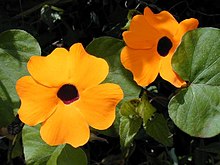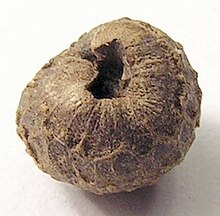Thunbergia alata
| Black-eyed Susan vine | |
|---|---|

| |
| Scientific classification | |
| Kingdom: | |
| (unranked): | |
| (unranked): | |
| (unranked): | |
| Order: | |
| Family: | |
| Genus: | |
| Species: | T. alata
|
| Binomial name | |
| Thunbergia alata | |
Thunbergia alata, commonly called Black-eyed Susan vine,[1] is a herbaceous perennial climbing plant species in the Acanthaceae family. It is native to Eastern Africa, and has been naturalized in other parts of the world. It is found in Cerrado vegetation of Brazil and Hawaii, along with eastern Australia and the southern USA in the states of Texas and Florida.[2]
It is grown as an ornamental plant in gardens and in hanging baskets. The name 'Black-eyed Susan' is thought to have come from a character that figures in many traditional ballads and songs. In the Ballad of Black-eyed Susan by John Gay, Susan goes aboard a ship in-dock to ask the sailors, where her lover Sweet William has gone. Black-eyed Susan is also a name given to other species of flowers in the genus Rudbeckia.
Description

Thunbergia alata has a vine habit, and can grow to a height of 6–8 ft (1.8-2.4 m) in tropical zones, or much less as a container plant or as an annual. It has twining stems with heart or arrow-shaped leaves. The flowers have five petals and appear throughout the growing season. They typically are warm orange with a characteristic dark spot in the centre, although different varieties can be red, orange, red-orange, white, pale yellow, or bright yellow, with or without the characteristic chocolate-purple centre which inspires the common name.[1]
Cultivation



Thunbergia alata seed is easy to germinate in humus-rich soil with some sand. Soaking the seeds in a dish of warm water over night will help improve seed germination when planted. It is a fast grower, blooming quickly, with light trimming encouraging more blossoms.[1]
Synonyms
- Endomelas alata ( ex Sims) Raf.
- Thunbergia alata ex Sims var. fryeri (Vilm.) Hasselbr.
- Thunbergia alata Bojer ex Sims var. albiflora Kuntze
- Thunbergia alata Bojer ex Sims var. aurantiaca Kuntze
- Thunbergia alata Bojer ex Sims var. bakeri Hasselbr.
- Thunbergia alata Bojer ex Sims var. vixalata Burkill
- Thunbergia alata Bojer ex Sims var. lutea Hasselbr.
- Thunbergia alata Bojer ex Sims var. reticulata (Hochst. ex Nees) Burkill
- Thunbergia alata Bojer ex Sims subvar. doddsii (Paxton) Hasselbr.
- Thunbergia alata Bojer ex Sims var. sulphurea Hasselbr.
- Thunbergia alata Bojer ex Sims var. albiflora Hook.
- Thunbergia alata Bojer ex Sims var. alba Paxton
- Thunbergia alata Bojer ex Sims var. retinervia Burkill
- Thunbergia albiflora (Hook.) Gordon
- Thunbergia aurantiaca Paxton
- Thunbergia backeri Vilm.
- Thunbergia doddsii Paxton
- Thunbergia fryeri Vilm.
- Thunbergia manganjensis T. Anderson ex Lindau
- Thunbergia reticulata Hochst. ex Nees
See also
References
External links
- Atlas of Florida Vascular Plants: Thunbergia alata
- Thunbergia alata
- Template:Pt icon Thunbergia alata
- Template:Es icon Thunbergia alata
- Thunbergia alata in West African plants – A Photo Guide.
